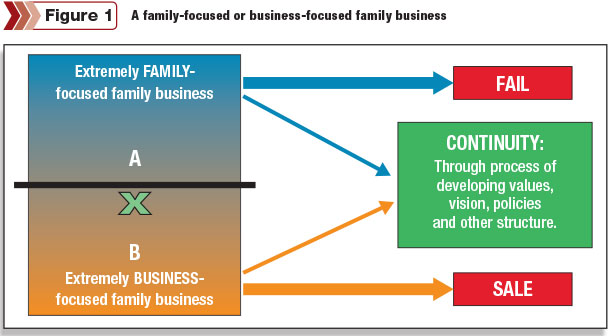As I mentioned in my last article in the Aug. 7 issue, the following is a trick question: “Is yours a family-first or business-first family business?” Your answer should be “neither” and “both.” Running your business to only care for family needs will eventually crush a successful business.
Focusing solely on the business to the exclusion of family values and legacy might create a profitable venture, but it’s more likely to be sold than to continue. In my last article, I illustrated the characteristics of being a family-focused family business or a business-focused family business. I also outlined two family businesses who found themselves in each of these positions.
The challenge here appears to be landing at the furthest ends of a continuum – at one end is an extremely family-focused family business. On the other is an extremely business-focused family business. To maximize the chance of continuity, family businesses should articulate where they fall on the continuum – between the extremes.
In fact, most businesses naturally fall somewhere in the middle of these two extremes. So the true challenge isn’t ending up at the extreme end of this continuum. Rather, it is not having discussions to collectively choose where the family business system belongs upon the continuum. Left to their own singular expectations, some members of the family believe the family business to be at point A in Figure 1.

Others think it is at B. And others fluctuate, depending on the day. The longest-lived family businesses tend to fall slightly past center toward the business-focused end of the scale (the X in Figure 1).
And even if continuity is not the ultimate goal of your family business, being deliberate about where your family business lives on this continuum will help preserve family relationships.
One of the ways you can approach making the deliberate choice about where your family business lies on the continuum is to jointly create family business policies.
“Policies do not just guide decisions about business but guide decisions about the relationship between the family and the business.”
—Developing Family Business Policies: Your Guide to the Future. Craig Aranoff, Joseph Astrachan, John Ward.
One tricky part of policy development is: The best time to develop one is before you need it. When a policy is developed after a conflict takes place, it inevitably becomes about a person. For example, a policy that all next-generation owners must enter into prenuptial agreements, developed when all the next-gens are 13 years old, can be explained as being in the best interest of the business.
The very same policy, developed three months after the first next-gen becomes engaged, becomes a policy focused on that fiancée. I know one family business in which the prenuptial policy is referred to as the “Ashley Rule.” All 14 next-gens are now married – but the policy was instituted a few months after the first next-gen family member was engaged to Ashley.
The second charge in policy development is using a fair process in its creation. First, get the “right” group involved. The “right” group depends on the size and complexity of your family business, of course. Consider including spouses in development of policy that impacts the next generation – even if those spouses don’t work in the business. If your family business stakeholder group is larger than six, you may need a representative group to develop policy.
In this case, taking volunteers to participate is an important step. Appointing the representative group does not contribute to a fair process. Second, ensure the policy is shared with all who may be affected. And be sure to share the policy at least three times. A fair process allows folks to get comfortable with a result – even if they disagree with it.
Here is a summary of the keys to policy development:
- Develop the policy before you need it to de-personalize its application.
- Get a broad group involved in policy creation.
- Communicate the process and results widely within the family and the business.
So which policies do you need first? Top on the list is guidance on how you earn the right to become an employee of the family business.
Family employment guidelines
This issue sneaks up on most family businesses – many have a family member employed even before they even think of themselves as a family business. Family employment guidelines set expectations and define best practices for how to engage family members. They allow family members to know expectations for employment. Here are some questions to answer as you develop your guidelines:
- Define the purpose. Why are you developing this guideline?
- Who does the guideline apply to? What is the definition of family?
- How will the hiring decision be made?
- Under what conditions (if any) will a position be created for a family member?
- What qualifications are required? Include details around attitude and behaviors, education, work experience and skills.
- What factors will determine the level of compensation?
You should have a few variations of the Family Employment Guidelines for your family business. In addition to the above, also answer the following questions for these specific types of employment.
Part-time seasonal work (for summer middle- or high-school work)
- At what age can family be employed in the family business?
- How many hours per week can they work?
Full-time seasonal work (for temporary employment)
- How long can a temporary, seasonal position be held by a family member?
- How is the decision made to convert a seasonal employee into a full-time permanent employee?
Management level work (someone who enters a role that includes supervisory responsibility)
- Are there any additional skills or capabilities needed?
As demonstrated by this example, balancing the “family-focused” and “business-focused” approach requires discussion and deliberation. And a fair process that starts before you need the policy, includes the right folks and is communicated thoroughly is most likely to result in strong family relationships and a healthy, successful business.
As I’ve shared in the past, developing guidelines or policies that provide “enough” structure can feel overly formal – especially when you start early – before the policy applies to a particular person. Whether or not continuity is your family business goal, it’s well worth the investment of time and energy to choose the right balance for your family business. PD

-
Barb Dartt
- Consultant
- The Family Business Consulting Group
- Email Barb Dartt






